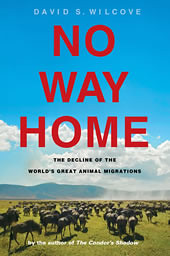As I stood on the deck of our motel room in Lincoln City, Oregon this past week-end looking out at the waves of the vast Pacific Ocean and watching the sun set, I couldn’t help but notice the beginnings of the southward movement of many different bird species. Most noticeable of these, owing to their size, were the flights of Brown Pelicans, Pelecanus occidentalis, winging their way south in single file lines of from just a few to a few dozen birds. As I heard the voice of our eight-year-old daughter playing inside the room, I began to wonder if she would be able to stand in the same place when she reaches my age and witness a repetition of this age-old cycle of migration for herself. Would she be able to show it to her own children or would it be simply a story she would tell them that their grandfather told her?
Perhaps the motivation for these forward looking contemplations was the book that I was in the process of reviewing, No Way Home: The Decline of the World’s Great Animal Migrations by David S. Wilcove. Wilcove, or more properly Professor Wilcove, is professor of ecology, evolution, and public affairs at Princeton University as well as one of the world’s leading authorities on endangered species. Possessing the deep level of expertise in both natural science and public policy necessary to write such a superb book addressing simultaneously the scientific underpinnings of wildlife migration, the ecological balances and disruptions to them wrought by mankind over the centuries and continuing to this very day, and the trans-jurisdictional and often transnational efforts either planned, attempted, underway, or abandoned related to their conservation, Professor Wilcove has with the publication of No Way Home presented the world what may very well be one of the finest treatises on the subject ever written for a general audience.
My problem was how to review it. It is a challenge I have been contemplating for some time now, much – no doubt – to the great annoyance of the good people at Island Press who graciously provided me the book for that expressed purpose. Yet to review it properly, I must be able to provide the potential reader with a portrait of the work in miniature, one that will convey a sense of my own estimation of the book’s worth in relation to its subject as well as provide a defensible encouragement or dissuasion to said reader’s taking up the book for him or herself. The difficulty I was having in reviewing Now Way Home is that upon originally completing my reading of the book my strongest desire was to get something into print that read simply “GO GET A COPY OF THIS BOOK AND READ IT NOW!” Editors frown on such reviews.
In the end, I was able to put to paper (well, electronic impulses anyway – it’s just not as poetic) a more nuanced and thoughtful review of the work. This will eventually find its way into press and I will be sure to bring it to the attention of the good readers of Born Again Bird Watcher when it does. However should any think they have gained a sense of my critical judgment of the book as contained in the as-of-yet unpublished review and think it safe to venture forth to their local bookseller to acquire a copy for their own reading enjoyment, I would entirely understand their actions and wish them good reading.
Title: No Way Home: The Decline of the World’s Great Animal Migrations
Author: David S. Wilcove
Hardback, 245 pages
Publisher: Island Press
Publication Date: October 15, 2007
ISBN-10: 1559639857
ISBN-13: 978-1559639859
In accordance with Federal Trade Commission 16 CFR Part 255, it is disclosed that the copy of the book read in order to produce this review was provided gratis to the reviewer by the publisher.

